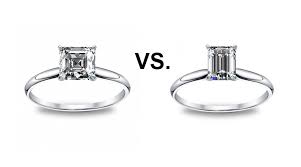When you’re looking for diamond jewelry you’re looking for the stone to sparkle in every direction. The sparkle (also called brilliance) is the product of the shape and cut. The cut of a diamond has a significant impact on its appearance. This is why it’s crucial to be attentive to this aspect if you are looking for a diamond with incredible brilliance, fire and gleam.
In the myriad of cuts, Asscher and emerald cuts are notable for their style and class. How do you determine which one is best for you? We’ll look at both the Asscher cut diamond against. the Emerald cut diamond, going into their distinct qualities, advantages, and differences. If you’re seeking elegant elegance or a vintage look, knowing the differences between the differences between these cuts will allow you to make an informed choice.
What is the definition of an Asscher Cut?
The Asscher cut Black Diamond was invented through the work of Dutch diamante cutter Joseph Asscher in 1902. Asscher saw the benefits of making use of rough diamond crystals in order to hold more weight than other cuts. The cut gained popularity during the Art-Deco movement, and has increased to become popular in the past decade with brides in America. United States.
Its Asscher cut is a square shape with facets that are deep and layered and an octagonal shape that is distinctive. It features 58 bigger, broad-set facets, with three rows on top and bottom. There are two major variants in the Asscher cut that are the traditional Asscher as well as the Royal Asscher.
The Asscher cut is akin to the cut emerald, and is sometimes referred to as the “square cut of emeralds.’
What is the definition of an Emerald Cut?
It was developed specifically to be used with stones made of emerald during the 1500s, thus the name. It gained popularity in the Art Deco movement in the 1920s, an era that was a time when clear lines, symmetry, and geometric shapes were sought-after.
The emerald cut is one of the most sought-after kinds of step-cut. It has an elongated square (or square) form with straight parallel facets as well as beveled corners. The emerald cut comes with 50-58 facets, which makes Asscher cut aspects and emerald cut almost identical.
Differentialities There are some differences Asscher Cut and Emerald Cut
Let’s explore the advantages and disadvantages of Asscher and Emerald cut diamonds to determine which is best for you. There are many things to think about when selecting the best cut.
Ratio of Length to Width
The ratio of length-to-width in diamonds determines the proportions of the diamond when seen from above, revealing how elongated or squared it is.
Asscher cut: The shape is square (or an octagonal) with a length-to-width ratio of approximately 1.00 up to 1.05.
Emerald Cut A rectangular, elongated shape with a width-to-length ratio that ranges between 1.30 and 1.60 (or 1.50 in the opinion of the majority of people).
Depth
The diamond’s depth refers to the overall size that extends from the top of the table, and continues to the culet (the tiny edge at the very bottom). In general, the less total depth is, the greater.
Asscher Cut Search for diamonds with a thickness between 60 and 68 percent, since depth affects the reflection of light within the diamond.
Emerald Cut: You should aim for a thickness of less than 74% to get stunning diamonds, however the emerald cut diamonds aren’t evaluated based on cut.
Table
The table of a diamond is the biggest facet. It is visible when viewing the stone from the side. The table’s facet plays a crucial aspect in the brilliance of diamonds as it reflects light that penetrates the stone and permits reflection back into the pavilion.
Asscher Cut The cut needs an extra-large table like windows in the middle. A table with a size between 60 to 68% is able to preserve the beautiful cut without affecting the dispersion of light.
Emerald Cut A larger table that ranges between 61% and 69%, providing an excellent view of the central area of the stone, as well as its inclusions, if there are any.
Facets & Brilliance
Facets are flat surfaces that are arranged geometrically on stones to create stunning designs that boost its shine. The more facets a gemstone has, the more bright it shines. Here are the main differences between Asscher cut facets and. the emerald cut facets as well as brilliance:
Asscher Cut The standard cut typically has 58 bigger step facets that increase brilliance and light. Asscher Cut Royal Asscher cut is 74 facets.
Emerald Cut This cut features 50 to 58 lengthy linear diamonds with facets. The step-cut was designed to provide diamonds with a soft elegant sparkle.
The brilliance of asscher cut diamonds vs Emerald cut black diamonds is equal with regard to the facets.
Polish and Symmetry
Polish is the term used to describe how polished diamond’s facets feel, and symmetry refers to the exact alignment of the facets. Diamonds reflect more light when they are polished and the symmetry grade ranges in quality from excellent to good. Both Asscher and emerald cuts are offered in these categories.
Clarity
Clarity is the term used to describe the presence of imperfections or inclusions within the stone.
Asscher Cut and Emerald Cut: Both types aren’t able to hide inclusions because of their huge tables. Therefore, selecting the clearer grades is advised in case you don’t want any visible inclusions surfacing from the stone.
Color
Like clearness, the two cuts reflect the natural stone’s hue due to their huge tables and the facets. So, if you choose to use the two cuts above, it’s suggested that you select stones with higher colors.
Designing Styles and Styles
When deciding on the style and design of the engagement ring Take a look at these popular settings:
Solitaire The design draws the eye to the diamond and perfectly demonstrates the unique design in the Asscher cut or Emerald cut diamond.
Halo It has smaller stone surrounding the central stone, increasing its shine and dimensions. Geometric patterns in the Asscher and cut emeralds make them perfectly suitable for this setting.
Pave With smaller sized accent stones incorporated into the band, increasing the fire of the central stone.
Three-stones: Asscher or Emerald-cut diamonds, because the center stone is stunning and is surrounded by stones to either side. The setting is symbolic especially for couples, indicating their past and present together.
Asscher Cut vs. Emerald Cut: Price Comparison
Generally speaking, diamonds cut with Asscher are a bit more costly than diamonds cut with emeralds due to their brilliance and sophistication. However, the price of both cuts is dependent on the diamond’s quality.
One-carat Asscher cut diamond could be priced between $3,500 and more than $5,500. A one-carat emerald cut diamond can range between $1,494 up to more than $8,375.
At Angara we offer Asscher diamond rings priced between $4,014 and 100,000+, whereas our Emerald-cut diamond rings can be as low as $747 up to more than $100,000.
Asscher and. Emerald Cut: Which Diamond Cut Should You Go for?
The best cut for you will depend on the budget you have and your preferences. If you prefer a square cut, go for an Asscher cut diamond or a square cut with emerald. If you’re looking for a bigger cut, select an emerald cut diamond.
For a classic look for a retro look, you can choose the Asscher cut that is perfect for a vintage look. If you want to look elegant, go with an emerald-cut. If you are looking for a size the emerald cut is the best option. Keep in mind that the decision is yours to make!





